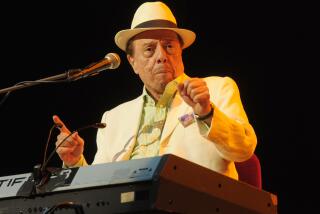Horta Riding Rising Tide of Brazilian Music : Jazz: His music is a blend of Brazilian folk, pop, jazz, <i> bossa nova </i> and a folk rhythm called <i> modinha mineira</i> .
- Share via
What’s new for jazz in the ‘90s? How about Brazilian music? OK, we’ve all heard that song before. Ever since Jelly Roll Morton advised us about the importance of the “Spanish tinge,” Latin American influences have ebbed and flowed through both jazz and pop.
Tonight Brazilian guitarist Tonino Horta, appearing at Vertigo in downtown Los Angeles, will bring yet another slant to what seems to be an unending story.
Horta is a well-established guitarist, composer, arranger and singer who has worked with everyone from Milton Nascimento to Pat Metheny. His songs have been recorded by such well-known performers as Flora Purim, Dori Caymmi, Sergio Mendes and Norman Connors.
Like Nascimento, Horta comes from the mountainous province of Minas Gerais. They are the two best-known representatives of a sound that has become a major factor in contemporary Brazilian music. Unlike Nascimento, however, Horta clearly has a love affair with jazz. His music is a remarkable blend of Brazilian folk, pop, jazz, bossa nova and modinha mineira (a folk rhythm from Minas Gerais).
He is, however, remarkably modest about his own performing skills. “I love to play the guitar,” he said last week. “But I can’t play like Pat Metheny. I have special tastes, and a style maybe that’s different from other players, but I am not a very good guitarist.
“I try to find the best notes when I make a solo--the special notes,” Horta continued. “To me, it’s important to show the conception of the song--the whole thing--rather than just show me playing as soloist.”
Other observers are not quite so reticent about Horta’s skills. With Pat Metheny’s description of him as “one of the most harmonically sophisticated and melodically satisfying composers of recent times” and a stack of reviews using such superlatives as eloquent, inventive, graceful and habit-forming, Horta’s music clearly is making a significant impact.
But is it riding the crest of a new Brazilian wave? James (Gustavo) Li, owner of Cafe Connection, one of Beverly Hills’ real flash points for Brazilian music, views the situation from a somewhat different perspective.
“I feel as though we’re in the middle of a trend,” he said last week. “It probably will last for another year or so, just like earlier Brazilian trends. But if the music is handled carefully and presented in the right venues, it could be a long-term thing.”
In fact, Horta’s current tour may have touched some of the wrong venues, with relatively small audiences showing up in some of the larger Midwest locales. Local performances by other Brazilian artists, usually in smaller clubs, have done considerably better.
The last month or so has seen appearances by Eliane Estevao at Catalina’s, and Ana Karam and Antonio Adofo at Le Cafe (which regularly features Brazilian musicians). Djavan brings his pop/rock samba to the Palace Theatre and The Strand next week for his second booking in the area in a year.
In addition, Li’s Cafe Connection has expanded its Brazilian music schedule to three nights a week (Thursday, Friday and Saturday) and Brazilian cuisine will be on the menu six days a week.
The flurry of activity is an indication that, as Li suggests, currents of Brazilian music and culture are surging throughout the Southland.
They will no doubt be given greater impetus by Horta’s performance tonight at Vertigo (he also appears at San Diego’s the Bacchanal on Wednesday). Of all the Brazilian artists moving through Los Angeles in recent months, he may have achieved the most attractive and accessible mixture of the musics of North and South America.
Typically, he made a case for his music with soft-spoken understatement. “The United States has the best guitar players in the world,” said Horta. “But maybe I can show them how to be a little more natural.”
“That’s what’s important to me--to make the melody and the harmony and the rhythm come together nice and easy. I think that’s something I do pretty good.”
More to Read
The biggest entertainment stories
Get our big stories about Hollywood, film, television, music, arts, culture and more right in your inbox as soon as they publish.
You may occasionally receive promotional content from the Los Angeles Times.










